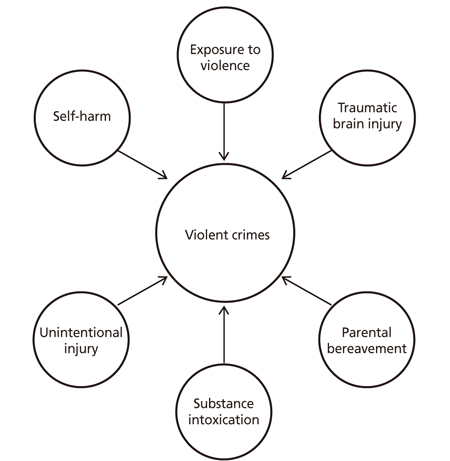J Korean Med Assoc.
2016 Dec;59(12):947-952. 10.5124/jkma.2016.59.12.947.
Violent behavior in individuals with schizophrenia
- Affiliations
-
- 1Department of Psychiatry, Yonsei University College of Medicine, Seoul, Korea. ansk@yuhs.ac
- 2Section of Self, Affect and Neuroscience, Institute of Behavioral Science in Medicine, Yonsei University College of Medicine, Seoul, Korea.
- KMID: 2364059
- DOI: http://doi.org/10.5124/jkma.2016.59.12.947
Abstract
- Violence in individuals with schizophrenia and other psychotic disorders is known to be higher than in the general population, according to various definitions of violence, although most people with schizophrenia are not violent. Various factors are reported to increase the risk of violence: demographic characteristics such as male gender, young age, and low socioeconomic status; antisocial personality and history of conduct disorder; comorbidity of substance abuse; psychopathological-clinical variables including positive psychotic symptoms, duration of the untreated psychosis, and the first episode of psychosis; and cognitive disorders. There are 3 types of violent patients with schizophrenia: 1) violent patients with a history of conduct disorder prior to the onset of schizophrenia; 2) violent patients in an acute psychotic episode, with no history of conduct disorder prior to the onset of schizophrenia; and 3) chronically violent patients who show no aggressive behavior prior to their thirties and early forties, and then are engaged in serious violence often including homicide. There are some identified triggering factors including exposure to violence, traumatic brain injury, self-harm, unintentional injury, substance intoxication and parental bereavement. The preventive and treatment strategies will be discussed according to the two different pathways of violence that are classified by the history of conduct disorder. A scientific approach is essential to reduce the rates of violent behaviors and potentially related stigma in patients with schizophrenia.
MeSH Terms
Figure
Reference
-
1. Kooyman I, Dean K, Harvey S, Walsh E. Outcomes of public concern in schizophrenia. Br J Psychiatry Suppl. 2007; 50:s29–s36.
Article2. Van Dorn RA, Swanson JW, Elbogen EB, Swartz MS. A comparison of stigmatizing attitudes toward persons with schizophrenia in four stakeholder groups: perceived likelihood of violence and desire for social distance. Psychiatry. 2005; 68:152–163.
Article3. Park JH, Choi YM, Kim B, Lee DW, Gim MS. Use of the terms “schizophrenia” and “schizophrenic” in the South Korean news media: a content analysis of newspapers and news programs in the last 10 years. Psychiatry Investig. 2012; 9:17–24.
Article4. Torrey EF. Stigma and violence: isn't it time to connect the dots? Schizophr Bull. 2011; 37:892–896.
Article5. Volavka J. Violence in schizophrenia and bipolar disorder. Psychiatr Danub. 2013; 25:24–33.6. MacArthur Research Network on Mental Health and the Law. The MacArthur violence risk assessment study [Internet]. Charlottesville: MacArthur Research Network on Mental Health and the Law;2001. cited 2016 Nov 24. Available from:http://www.macarthur.virginia.edu/risk.html.7. Monahan J, Steadman HJ, Silver E, Appelbaum PS, Robbins PC, Mulvey EP, Roth LH, Grisso T, Banks S. Rethinking risk assessment: the MacArthur study of mental disorder and violence. New York: Oxford University Press;2001.8. Shaw J, Hunt IM, Flynn S, Meehan J, Robinson J, Bickley H, Parsons R, McCann K, Burns J, Amos T, Kapur N, Appleby L. Rates of mental disorder in people convicted of homicide: national clinical survey. Br J Psychiatry. 2006; 188:143–147.
Article9. Swanson JW, Holzer CE 3rd, Ganju VK, Jono RT. Violence and psychiatric disorder in the community: evidence from the Epidemiologic Catchment Area surveys. Hosp Community Psychiatry. 1990; 41:761–770.
Article10. Fazel S, Gulati G, Linsell L, Geddes JR, Grann M. Schizophrenia and violence: systematic review and meta-analysis. PLoS Med. 2009; 6:e1000120.
Article11. Silverstein SM, Pozzo JD, Roche M, Boyle D, Miskimen T. Schizophrenia and violence: realities and recommendations. Crime Psychol Rev. 2015; 1:21–42.
Article12. Bo S, Abu-Akel A, Kongerslev M, Haahr UH, Simonsen E. Risk factors for violence among patients with schizophrenia. Clin Psychol Rev. 2011; 31:711–726.
Article13. Nielssen O, Large M. Rates of homicide during the first episode of psychosis and after treatment: a systematic review and meta-analysis. Schizophr Bull. 2010; 36:702–712.
Article14. Choi J, Park SC. Correlates of violence in patients with schizophrenia. Korean J Schizophr Res. 2015; 18:10–15.
Article15. Hodgins S. Violent behaviour among people with schizophrenia: a framework for investigations of causes, and effective treatment, and prevention. Philos Trans R Soc Lond B Biol Sci. 2008; 363:2505–2518.
Article16. Kim-Cohen J, Caspi A, Moffitt TE, Harrington H, Milne BJ, Poulton R. Prior juvenile diagnoses in adults with mental disorder: developmental follow-back of a prospective-longitudinal cohort. Arch Gen Psychiatry. 2003; 60:709–717.
Article17. Sariaslan A, Lichtenstein P, Larsson H, Fazel S. Triggers for violent criminality in patients with psychotic disorders. JAMA Psychiatry. 2016; 73:796–803.
Article18. Kim WY, Kim SB, Kim MJ, Lee JY, Shim G, Ryu MK. A case-controlled study of cognitive behavioral therapy for patients with schizophrenia having violence-related crime. Korean J Schizophr Res. 2014; 17:80–85.
Article
- Full Text Links
- Actions
-
Cited
- CITED
-
- Close
- Share
- Similar articles
-
- A Case of Aggressive and Violent Patient with Treatment-Resistant Schizophrenia Treated with Long-Acting Injectable Risperidone
- Correlates of Violence in Patients with Schizophrenia
- Characteristics of Violent Behavior in Psychiatric Inpatients
- Biological Aspects of Aggression and Violence in Schizophrenia
- Impact of Age at Onset of Menarche on Subsequent Courses in Women with Schizophrenia


